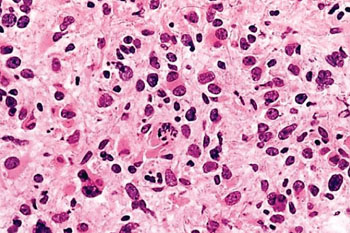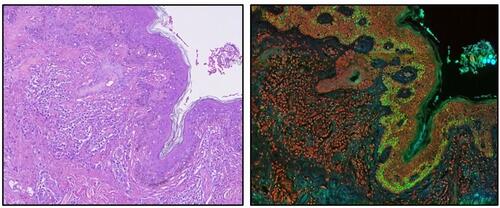Prognostic Marker Gene Found for Anaplastic Astrocytoma
By LabMedica International staff writers
Posted on 24 Jun 2015
A gene encoding for the enzyme isocitrate dehydrogenase 1 (IDH1) might be prognostic marker for a rare form of brain cancer known as anaplastic astrocytoma.Posted on 24 Jun 2015
Astrocytomas arise from astrocytes, star-shaped cells that help nourish and support nerve and blood-vessel cells in the brain. Anaplastic astrocytomas are grade III brain tumors that can become grade IV tumors, which are also called glioblastoma.

Image: Histopathology of an anaplastic astrocytoma showing marked nuclear pleomorphism. Note the atypical mitosis in the center (Photo courtesy of Dr. Peter C. Burger, MD).
Scientists at the Wexner Medical Center, Ohio State University (Columbus, OH, USA) carried out the IDH study as part of the phase III clinical trial Randomized Study of Radiation Therapy and Temozolomide Versus Radiation Therapy and Nitrosourea for Anaplastic Astrocytoma and Mixed Anaplastic Oligoastrocytoma (RTOG 9813), which involved 301 patients with anaplastic astrocytoma. The dual-arm trial evaluated the effectiveness of radiation therapy plus either of two chemotherapy drugs: temozolomide and nitrosourea.
The clinical trial showed no significant difference in survival in patients taking temozolomide compared with patients taking nitrosourea after a follow up of 3.6 years on average. However, the study also suggested a trend toward better survival for patients with mutated IDH who received radiation therapy plus temozolomide compared with patients receiving radiation therapy and nitrosourea. Patients in this study who had a mutated IDH gene lived an average of 7.9 years after diagnosis versus 2.8 years for patients with unaltered IDH.
Treatment of anaplastic astrocytomas first requires surgery to remove as much tumor as possible. Complete removal is often impossible, however, because the tumors typically develop projections that extend into healthy brain tissue. Radiation therapy is then used to kill any remaining tumor cells. Chemotherapy is often recommended during or after radiation or both.
Arnab Chakravarti, MD, chair and professor of Radiation Oncology and director of the Brain Tumor Program at Ohio State University, and co-author of the study said, “We found that IDH status is not only a significant prognostic biomarker for the classification of anaplastic gliomas, but there appears to be an interesting trend in the data which suggests that it might also be an important predictive biomarker for determining which type of chemotherapy patients should receive. If this novel finding is verified, it could have a critical influence on future patient care.” The study was presented at the American Society of Clinical Oncology annual meeting held May 29–June 2, 2015, in Chicago (IL, USA).
Related Links:
Wexner Medical Center













